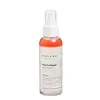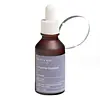What's inside
What's inside
 Key Ingredients
Key Ingredients

 Benefits
Benefits

 Concerns
Concerns

No concerns
 Ingredients Side-by-side
Ingredients Side-by-side

Water
Skin ConditioningGlycerin
HumectantEthylhexyl Palmitate
EmollientButylene Glycol
HumectantNiacinamide
SmoothingRosa Damascena Flower Water
MaskingCollagen Extract
Skin ConditioningHydrolyzed Collagen
EmollientSoluble Collagen
HumectantDipropylene Glycol
HumectantHelianthus Annuus Seed Oil
EmollientHydroxyacetophenone
AntioxidantBetaine
HumectantPersea Gratissima Oil
Skin ConditioningOlea Europaea Fruit Oil
Masking1,2-Hexanediol
Skin ConditioningAllantoin
Skin ConditioningAdenosine
Skin ConditioningAlkanna Tinctoria Root Extract
Skin ConditioningCaprylyl Glycol
EmollientDisodium EDTA
Pentylene Glycol
Skin ConditioningJojoba Oil/Macadamia Seed Oil Esters
Skin ConditioningSodium Hyaluronate
HumectantSqualene
EmollientSodium Hyaluronate Crosspolymer
HumectantEthylhexylglycerin
Skin ConditioningHydrolyzed Hyaluronic Acid
HumectantTocopherol
AntioxidantHyaluronic Acid
HumectantPhytosteryl Macadamiate
Skin ConditioningHydrolyzed Sodium Hyaluronate
Skin ConditioningPhytosterols
Skin ConditioningParfum
MaskingWater, Glycerin, Ethylhexyl Palmitate, Butylene Glycol, Niacinamide, Rosa Damascena Flower Water, Collagen Extract, Hydrolyzed Collagen, Soluble Collagen, Dipropylene Glycol, Helianthus Annuus Seed Oil, Hydroxyacetophenone, Betaine, Persea Gratissima Oil, Olea Europaea Fruit Oil, 1,2-Hexanediol, Allantoin, Adenosine, Alkanna Tinctoria Root Extract, Caprylyl Glycol, Disodium EDTA, Pentylene Glycol, Jojoba Oil/Macadamia Seed Oil Esters, Sodium Hyaluronate, Squalene, Sodium Hyaluronate Crosspolymer, Ethylhexylglycerin, Hydrolyzed Hyaluronic Acid, Tocopherol, Hyaluronic Acid, Phytosteryl Macadamiate, Hydrolyzed Sodium Hyaluronate, Phytosterols, Parfum
Water
Skin ConditioningGlycereth-26
Humectant1,2-Hexanediol
Skin ConditioningButylene Glycol
HumectantGlycerin
HumectantArginine
MaskingCarbomer
Emulsion StabilisingEthylhexylglycerin
Skin ConditioningPolyglyceryl-10 Laurate
Skin ConditioningAdenosine
Skin ConditioningCaprylyl Glycol
EmollientCopper Tripeptide-1
Skin ConditioningHexapeptide-11
Skin ConditioningHexapeptide-9
Skin ConditioningPalmitoyl Pentapeptide-4
Skin ConditioningPalmitoyl Tripeptide-1
Skin ConditioningTripeptide-1
Skin Conditioning
 Reviews
Reviews

Ingredients Explained
These ingredients are found in both products.
Ingredients higher up in an ingredient list are typically present in a larger amount.
1,2-Hexanediol is a synthetic liquid and another multi-functional powerhouse.
It is a:
- Humectant, drawing moisture into the skin
- Emollient, helping to soften skin
- Solvent, dispersing and stabilizing formulas
- Preservative booster, enhancing the antimicrobial activity of other preservatives
Adenosine is in every living organism. It is one of four components in nucleic acids that helps store our DNA.
Adenosine has many benefits when used. These benefits include hydrating the skin, smoothing skin, and reducing wrinkles. Once applied, adenosine increases collagen production. It also helps with improving firmness and tissue repair.
Studies have found adenosine may also help with wound healing.
In skincare products, Adenosine is usually derived from yeast.
Learn more about AdenosineButylene Glycol (or BG) is used within cosmetic products for a few different reasons:
Overall, Butylene Glycol is a safe and well-rounded ingredient that works well with other ingredients.
Though this ingredient works well with most skin types, some people with sensitive skin may experience a reaction such as allergic rashes, closed comedones, or itchiness.
Learn more about Butylene GlycolCaprylyl Glycol is a humectant and emollient, meaning it attracts and preserves moisture.
It is a common ingredient in many products, especially those designed to hydrate skin. The primary benefits are retaining moisture, skin softening, and promoting a healthy skin barrier.
Though Caprylyl Glycol is an alcohol derived from fatty acids, it is not the kind that can dry out skin.
This ingredient is also used as a preservative to extend the life of products. It has slight antimicrobial properties.
Learn more about Caprylyl GlycolEthylhexylglycerin (we can't pronounce this either) is commonly used as a preservative and skin softener. It is derived from glyceryl.
You might see Ethylhexylglycerin often paired with other preservatives such as phenoxyethanol. Ethylhexylglycerin has been found to increase the effectiveness of these other preservatives.
Glycerin is already naturally found in your skin. It helps moisturize and protect your skin.
A study from 2016 found glycerin to be more effective as a humectant than AHAs and hyaluronic acid.
As a humectant, it helps the skin stay hydrated by pulling moisture to your skin. The low molecular weight of glycerin allows it to pull moisture into the deeper layers of your skin.
Hydrated skin improves your skin barrier; Your skin barrier helps protect against irritants and bacteria.
Glycerin has also been found to have antimicrobial and antiviral properties. Due to these properties, glycerin is often used in wound and burn treatments.
In cosmetics, glycerin is usually derived from plants such as soybean or palm. However, it can also be sourced from animals, such as tallow or animal fat.
This ingredient is organic, colorless, odorless, and non-toxic.
Glycerin is the name for this ingredient in American English. British English uses Glycerol/Glycerine.
Learn more about GlycerinWater. It's the most common cosmetic ingredient of all. You'll usually see it at the top of ingredient lists, meaning that it makes up the largest part of the product.
So why is it so popular? Water most often acts as a solvent - this means that it helps dissolve other ingredients into the formulation.
You'll also recognize water as that liquid we all need to stay alive. If you see this, drink a glass of water. Stay hydrated!
Learn more about Water